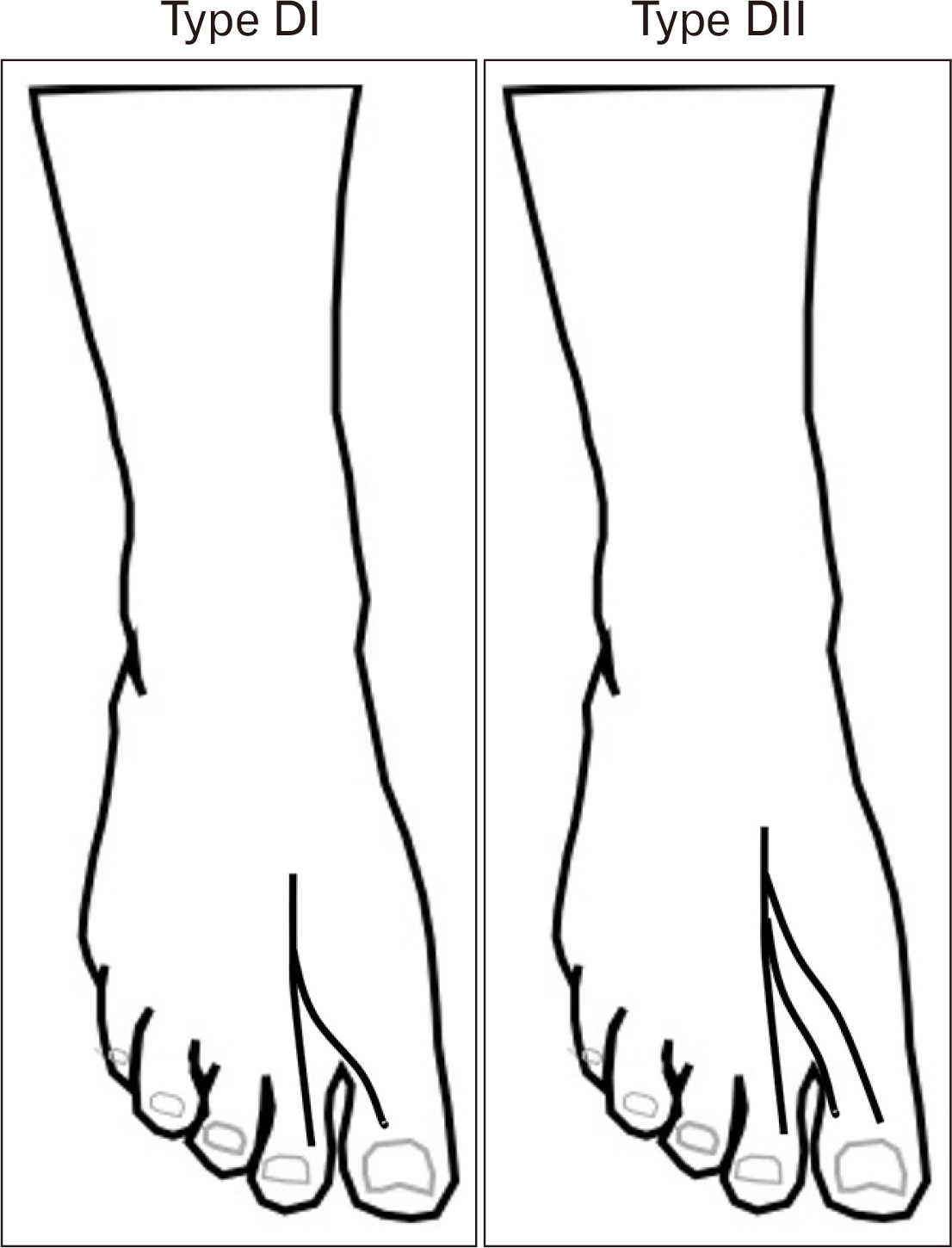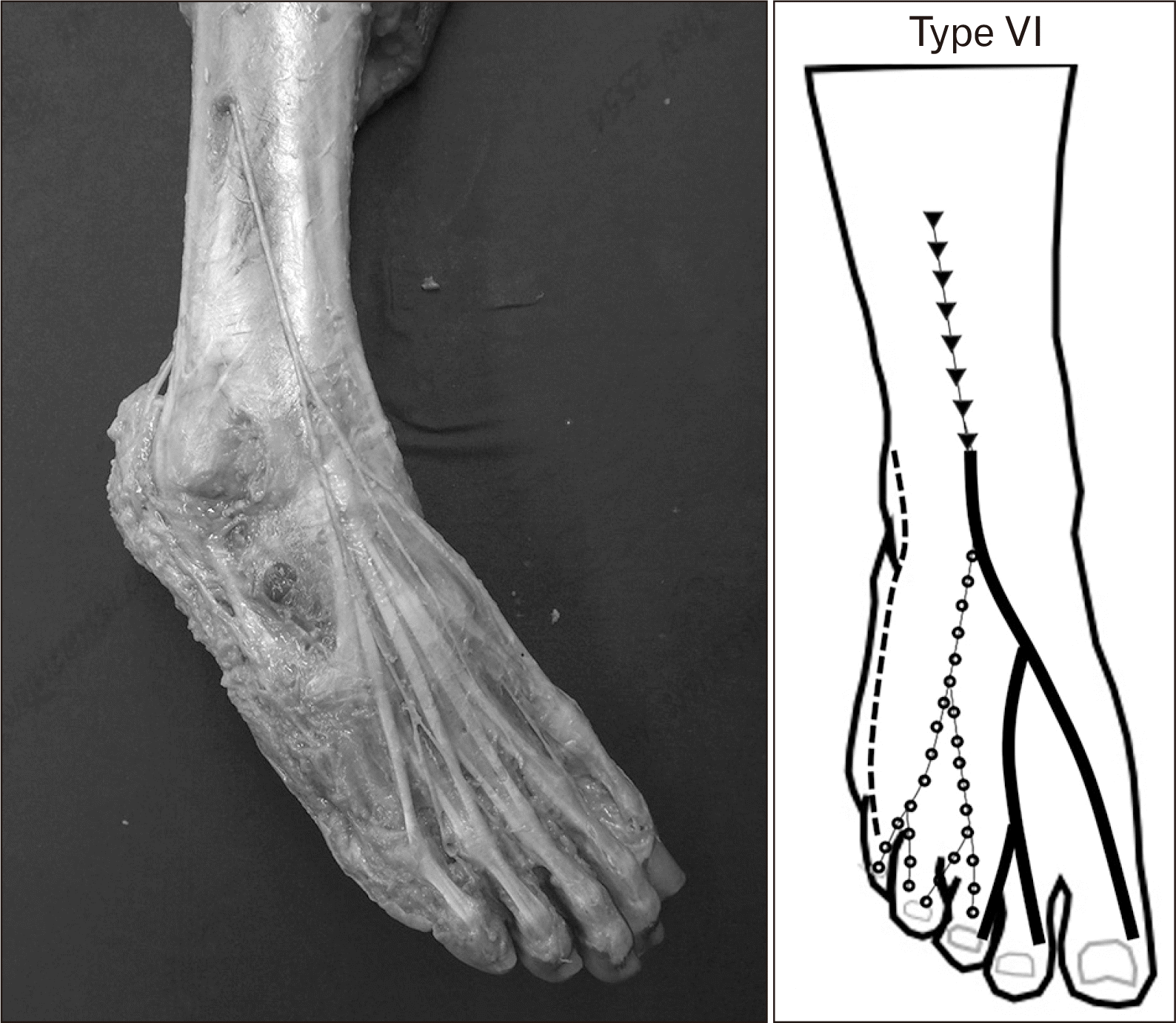2. Miller RA, Hartman G. 1996; Origin and course of the dorsomedial cutaneous nerve to the great toe. Foot Ankle Int. 17:620–2. DOI:
10.1177/107110079601701006. PMID:
8908488.

3. Blair JM, Botte MJ. 1994; Surgical anatomy of the superficial peroneal nerve in the ankle and foot. Clin Orthop Relat Res. (305):229–38. DOI:
10.1097/00003086-199408000-00028.

4. Canella C, Demondion X, Guillin R, Boutry N, Peltier J, Cotten A. 2009; Anatomic study of the superficial peroneal nerve using sonography. AJR Am J Roentgenol. 193:174–9. DOI:
10.2214/AJR.08.1898. PMID:
19542411.

5. Üçeyler N, Schäfer KA, Mackenrodt D, Sommer C, Müllges W. 2016; High-resolution ultrasonography of the superficial peroneal motor and sural sensory nerves may be a non-invasive approach to the diagnosis of vasculitic neuropathy. Front Neurol. 7:48. DOI:
10.3389/fneur.2016.00048. PMID:
27064457. PMCID:
PMC4812111.

7. Aktan Ikiz ZA, Uçerler H, Bilge O. 2005; The anatomic features of the sural nerve with an emphasis on its clinical importance. Foot Ankle Int. 26:560–7. DOI:
10.1177/107110070502600712. PMID:
16045849.
8. Kosinski C. 1926; The course, mutual relations and distribution of the cutaneous nerves of the Metazonal region of leg and foot. J Anat. 60(Pt 3):274–97.
9. Solomon LB, Ferris L, Tedman R, Henneberg M. 2001; Surgical anatomy of the sural and superficial fibular nerves with an emphasis on the approach to the lateral malleolus. J Anat. 199(Pt 6):717–23. DOI:
10.1046/j.1469-7580.2001.19960717.x. PMID:
11787825. PMCID:
PMC1468389.

10. Moore KL, Dalley AF, Agur AMR. 2006. Clinically oriented anatomy. 5th ed. Lippincott Williams & Wilkins;Philadelphia: p. 1–300.
11. Loveday DT, Nogaro MC, Calder JD, Carmichael J. 2013; Is there an anatomical marker for the deep peroneal nerve in midfoot surgical approaches? Clin Anat. 26:400–2. DOI:
10.1002/ca.22173. PMID:
23378070.

12. Causeret A, Ract I, Jouan J, Dreano T, Ropars M, Guillin R. 2018; A review of main anatomical and sonographic features of subcutaneous nerve injuries related to orthopedic surgery. Skeletal Radiol. 47:1051–68. DOI:
10.1007/s00256-018-2917-5. PMID:
29549379.

13. Mahakkanukrauh P, Chomsung R. 2002; Anatomical variations of the sural nerve. Clin Anat. 15:263–6. DOI:
10.1002/ca.10016. PMID:
12112352.

14. Madhavi C, Isaac B, Antoniswamy B, Holla SJ. 2005; Anatomical variations of the cutaneous innervation patterns of the sural nerve on the dorsum of the foot. Clin Anat. 18:206–9. DOI:
10.1002/ca.20094. PMID:
15768411.

15. Eid EM, Hegazy AM. 2011; Anatomical variations of the human sural nerve and its role in clinical and surgical procedures. Clin Anat. 24:237–45. DOI:
10.1002/ca.21068. PMID:
20949489.

16. Jeon SK, Paik DJ, Hwang YI. 2017; Variations in sural nerve formation pattern and distribution on the dorsum of the foot. Clin Anat. 30:525–32. DOI:
10.1002/ca.22873. PMID:
28281304.

17. Kelikian AS, Sarrafian SK. 2012. Sarrafian's anatomy of the foot and ankle: descriptive, topographic, functional. 3rd ed. Wolters Kluwer Health/Lippincott Williams & Wilkins;Philadelphia: p. 1–736.
18. Nayak VS, Bhat N, Nayak SS, Sumalatha S. 2019; Anatomical variations in the cutaneous innervation on the dorsum of the foot. Anat Cell Biol. 52:34–7. DOI:
10.5115/acb.2019.52.1.34. PMID:
30984449. PMCID:
PMC6449594.

19. Siclari A, Piras M. 2015; Hallux metatarsophalangeal arthroscopy: indications and techniques. Foot Ankle Clin. 20:109–22. DOI:
10.1016/j.fcl.2014.10.012. PMID:
25726487.
20. Vaseenon T, Phisitkul P. 2010; Arthroscopic debridement for first metatarsophalangeal joint arthrodesis with a 2-versus 3-portal technique: a cadaveric study. Arthroscopy. 26:1363–7. DOI:
10.1016/j.arthro.2010.02.015. PMID:
20887934.
21. Malagelada F, Vega J, Guelfi M, Kerkhoffs G, Karlsson J, Dalmau-Pastor M. 2020; Anatomic lectures on structures at risk prior to cadaveric courses reduce injury to the superficial peroneal nerve, the commonest complication in ankle arthroscopy. Knee Surg Sports Traumatol Arthrosc. 28:79–85. DOI:
10.1007/s00167-019-05373-x. PMID:
30729253.






 PDF
PDF Citation
Citation Print
Print







 XML Download
XML Download